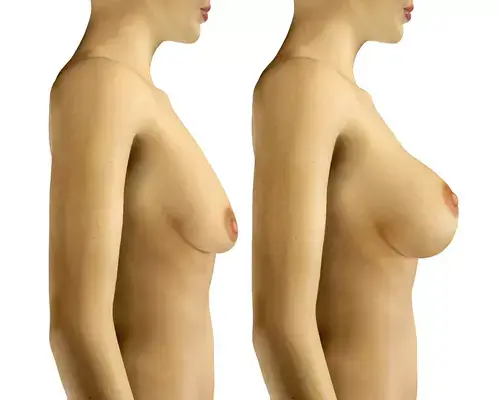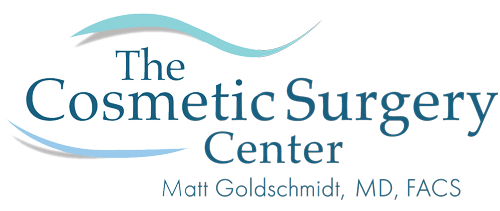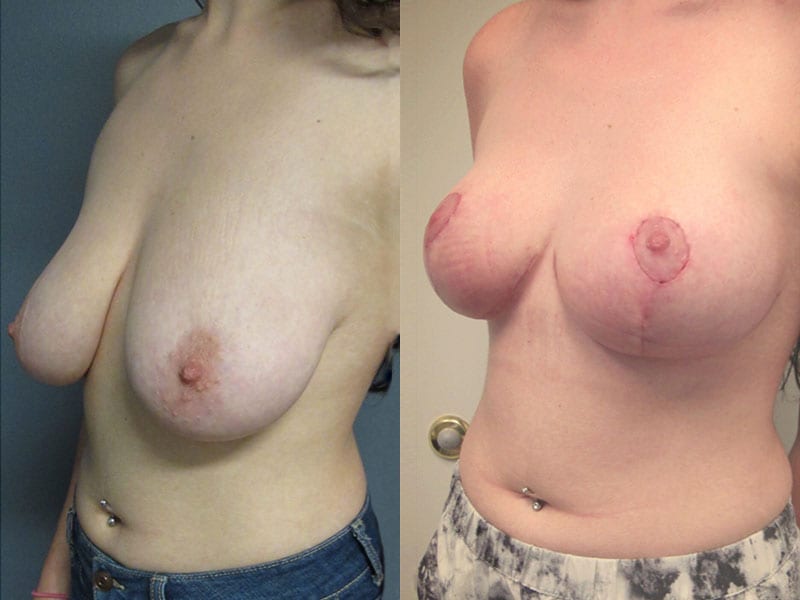Breast lift surgery is performed on women who have lost a significant amount of weight, have had multiple children, or have lost skin elasticity. Breast lift surgery removes stretched skin and tightens the underlying glandular tissue so the breasts return to a youthful and perky position on the chest.

What Causes Breast Sagging?
Sagging breasts, scientifically known as ptosis, is the descension of both the tissue and the nipple-areolar complex. The weight of the tissues, your pregnancy and breastfeeding history, and hormonal factors contribute to the weakening of the support structures and the drooping of your breasts. Ptosis is divided into four categories, and your treatment protocol will likely depend on your category.
- Grade I covers women with mild ptosis. Women with Grade I ptosis have nipples that are below the inframammary fold but above the lower pole.
- Grade II describes women with moderate ptosis where the nipples are further below the inframammary fold but still above some tissue on the lower pole.
- Grade III is severe sagging where the nipples are far below the pole, and there is little or no lower pole tissue.
- Pseudoptosis is a variation of ptosis where the lower pole tissue sags, but the nipple remains at or above the inframammary fold.
How Does Surgery Lift Sagging Breasts?
Periareolar Lift
A periareolar breast lift is an ideal choice for women who are starting to realize the effects of sagging. This option is only appropriate for women with Grade I sagging, and even then, a more extensive incision may be recommended.
The periareolar mastopexy uses two concentric incisions around the areola through which a “donut” of skin is removed and the incisions are brought together as one. While this option is not appropriate for women with larger chests, it does offer improvement with minimal breast lift scars.
Lollipop Lift
The lollipop breast lift allows for a higher degree of correction and is often appropriate for patients who experience Grade II, or moderate, ptosis. This incision runs around the areola and vertically down the bottom pole to the crease. While the nipple-areolar complex may be adjusted slightly, it cannot reposition the nipple as much as more extensive techniques.
Anchor lift
The anchor breast lift, also known as a “wise” pattern mastopexy, is the traditional technique for breast lift surgery. This option allows for the most significant amount of lift and is recommended for women who experience Grade II or Grade III ptosis.
The anchor incision is the most extensive, running around the areola and continuing down and along the lower crease. Even though the periareolar and lollipop incisions result in less scarring, they cannot achieve the same level of correction as the anchor technique.
This option allows Dr. Goldschmidt to remove a greater amount of skin, better tighten the tissue, and reposition the nipple to the center of the breast.
How Can You Maintain Your Results?
Keep a Stable Weight
Fluctuations in weight, especially the loss of weight, often speeds the rate in which the breasts experience ptosis. Maintaining a stable weight will relieve some of the pressure that leads to sagging and will prolong the results of your lift.
Wear a Supportive Bra
No matter what your chest size is, gravity will cause the weight of them to pull downward and the skin to stretch. This is why it is essential to wear a properly fitting, supportive bra. A good bra will help counteract the adverse effects of gravity and keep your tissues healthy.
Avoid Surgery Until You Are Done Having Children
Many women start to experience ptosis following one or more pregnancies. Between the rapid fluctuation in size during pregnancy and the amount of physical stress placed on the breasts when nursing, pregnancy is one of the most damaging times for your breast’s aesthetic appearance. Breast lift surgery will restore the breasts to a pre-pregnancy shape; however, additional pregnancies may stretch and loosen the tissue once again.
If you are interested in a breast lift, contact Dr. Goldschmidt by calling (216) 350-3175 or by filling out our online contact form.

